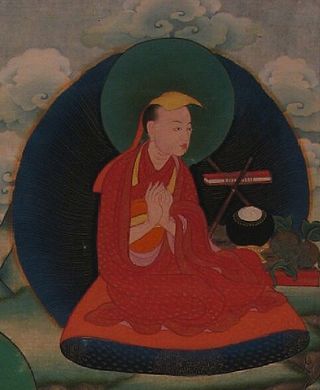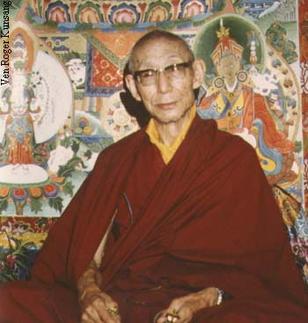
Dalai Lama is a title given by Altan Khan, the first Shunyi King of Ming China. He offered it in appreciation to the leader of the Gelug school of Tibetan Buddhism, Sonam Gyatso, who received it in 1578 at Yanghua Monastery. At that time, Sonam Gyatso had just given teachings to the Khan, and so the title of Dalai Lama was also given to the entire tulku lineage. Sonam Gyatso became the 3rd Dalai Lama, while the first two tulkus in the lineage, the 1st Dalai Lama and the 2nd Dalai Lama, were posthumously awarded the title.

The Gelug is the newest of the four major schools of Tibetan Buddhism. It was founded by Je Tsongkhapa (1357–1419), a Tibetan philosopher, tantric yogi and lama and further expanded and developed by his disciples.

The Ganden Tripa, also spelled Gaden Tripa, is the title of the spiritual leader of the Gelug school of Tibetan Buddhism, the school that controlled central Tibet from the mid-17th century until the 1950s. The 103rd Ganden Tripa, Jetsun Lobsang Tenzin, died in office on 21 April 2017. Currently, Jangtse Choejey Kyabje Jetsun Lobsang Tenzin Palsangpo is the 104th Ganden Tripa.
The Dorje Shugden controversy is a controversy over Dorje Shugden, also known as Dolgyal, whom some consider to be one of several protectors of the Gelug school, the school of Tibetan Buddhism to which the Dalai Lamas belong. Dorje Shugden has become the symbolic focal point of a conflict over the "purity" of the Gelug school and the inclusion of non-Gelug teachings, especially Nyingma ones.

The 2nd Dalai Lama, Gedun Gyatso, was also known as Yonten Phuntsok, or Gedun Gyatso Palzangpo. He was ordained at Tashilhunpo Monastery at Shigatse, and later resided at Drepung Monastery in Lhasa. He was posthumously entitled as the 2nd Dalai Lama.

The 5th Dalai Lama, Ngawang Lobsang Gyatso was recognized as the 5th Dalai Lama, and he became the first Dalai Lama to hold both Tibet's political and spiritual leadership roles. He is often referred to simply as the Great Fifth, being the key religious and temporal leader of Tibetan Buddhism and Tibet. He is credited with unifying all of Tibet under the Ganden Phodrang, after Gushri Khan's successful military interventions. As an independent head of state, he established priest and patron relations with both Mongolia and the Qing dynasty simultaneously, and had positive relations with other neighboring countries. He began the custom of meeting early European explorers. The 5th Dalai Lama built the Potala Palace, and also wrote 24 volumes' worth of scholarly and religious works on a wide range of subjects.

Sera Monastery is one of the "great three" Gelug university monasteries of Tibet, located 1.25 miles (2.01 km) north of Lhasa and about 5 km (3.1 mi) north of the Jokhang.

Ganden Monastery or Ganden Namgyeling or Monastery of Gahlden is one of the "great three" Gelug university monasteries located in Dagzê County, Lhasa, Tibet. The other two are Sera Monastery and Drepung Monastery. Ganden Monastery was founded in 1409 by Je Tsongkhapa Lozang-dragpa, founder of the Gelug order. The monastery was destroyed after 1959, but has since been partially rebuilt. Another monastery with the same name and tradition was established in Southern India in 1966 by Tibetan exiles.

Drepung Monastery, located at the foot of Mount Gephel, is one of the "great three" Gelug monasteries of Tibet founded by Je Tsongkhapa. The other two are Ganden Monastery and Sera Monastery. Drepung is the largest of all Tibetan monasteries and is located on the Gambo Utse mountain, five kilometers from the western suburb of Lhasa.

Pabongkhapa Déchen Nyingpo was a Gelug lama of the modern era of Tibetan Buddhism. He attained his Geshe degree at Sera Mey Monastic University, Lhasa, and became a teacher in Tibet. He teaches lay people. Pabongkha was offered the regency of the present Dalai Lama but declined the request because "he strongly disliked political affairs."
This is a list of topics related to Tibet.

Kumbum Monastery, also called Ta'er Temple, is a Tibetan gompa in Lusar, Huangzhong County, Xining, Qinghai, China. It was founded in 1583 at the site of Je Tsongkhapa's birth in a narrow valley close to the village of Lusar in the historical Tibetan region of Amdo. Its superior monastery is Drepung Monastery, immediately to the west of Lhasa. It is ranked in importance as second only to Lhasa.

Zong Rinpoche was a Gelug Lama and disciple of the third Trijang Rinpoche, junior tutor of the 14th Dalai Lama. He was famous as a sharp analyst and master of philosophical debate, as well as a Tantric practitioner. He was the Abbot of Ganden Shartse monastery.

Sönam Rapten, initially known as Gyalé Chödze and later on as Sönam Chöpel, was born in the Tholung valley in the Central Tibetan province of Ü. He started off as a monk-administrator of the Ganden Phodrang, the early Dalai Lamas' residence at Drepung Monastery, outside Lhasa, Tibet. From around or before the age of 20 he became the Treasurer and the "Chagdzo" of the Fourth (1589-1617) and, subsequently, the Fifth Dalai Lama (1617-1682). He presided as the most senior official of the Gelugpa school of Tibetan Buddhism for over 40 years.

Gongma Drakpa Gyaltsen was a king of Tibet who ruled in 1385–1432. He belonged to the Phagmodrupa dynasty, which was the leading regime in Tibet between 1354 and 1435. His reign was comparatively tranquil, but he was also the last ruler of the dynasty to wield full powers over the central parts of Tibet.

Kyabje Yongzin Ling Rinpoche is a Tibetan tulku. The best-known incarnation is the sixth incarnation, Thupten Lungtok Namgyal Thinley, a Tibetan buddhist scholar and teacher.

The Third Trijang Rinpoche, Lobsang Yeshe Tenzin Gyatso (1901–1981) was a Gelugpa Lama and a direct disciple of Pabongkhapa Déchen Nyingpo. He succeeded Ling Rinpoche as the junior tutor of the 14th Dalai Lama when the Dalai Lama was nineteen years old. He was also a lama of many Gelug lamas who taught in the West including Zong Rinpoche, Geshe Rabten, Lama Yeshe, Kelsang Gyatso, and Lama Zopa Rinpoche. Trijang Rinpoche's oral teachings were recorded by Zimey Rinpoche in a book called the Yellow Book.
Tsenzhab Serkong Rinpoche was a master (tsenshab) of Tibetan Buddhism from the Gelug tradition. At the age of 34 in 1948 he was appointed from Ganden Jangtsey Monastery near Lhasa as one of seven teachers for the Dalai Lama.
Jangsem Sherab Zangpo, also known as Jangsem Sherab Sangpo, (1395-1457) was a 15th-century Buddhist monk and teacher, and one of the six contemporary disciples of Je Tsongkhapa, the founder of one of the newest school of Tibetan Buddhism, the Gelug school. He is crediting with establishing the famed Thikse Monastery and the remotely located Phugtal Monastery in Ladakh, in the North Indian state of Jammu and Kashmir.

Although there were many householder-yogis in Tibet, monasticism was the foundation of Buddhism in Tibet. There were over 6,000 monasteries in Tibet. However, nearly all of these were ransacked and destroyed by Red Guards during the Cultural Revolution. Most of the major monasteries have been at least partially re-established, while many others remain in ruins.

















